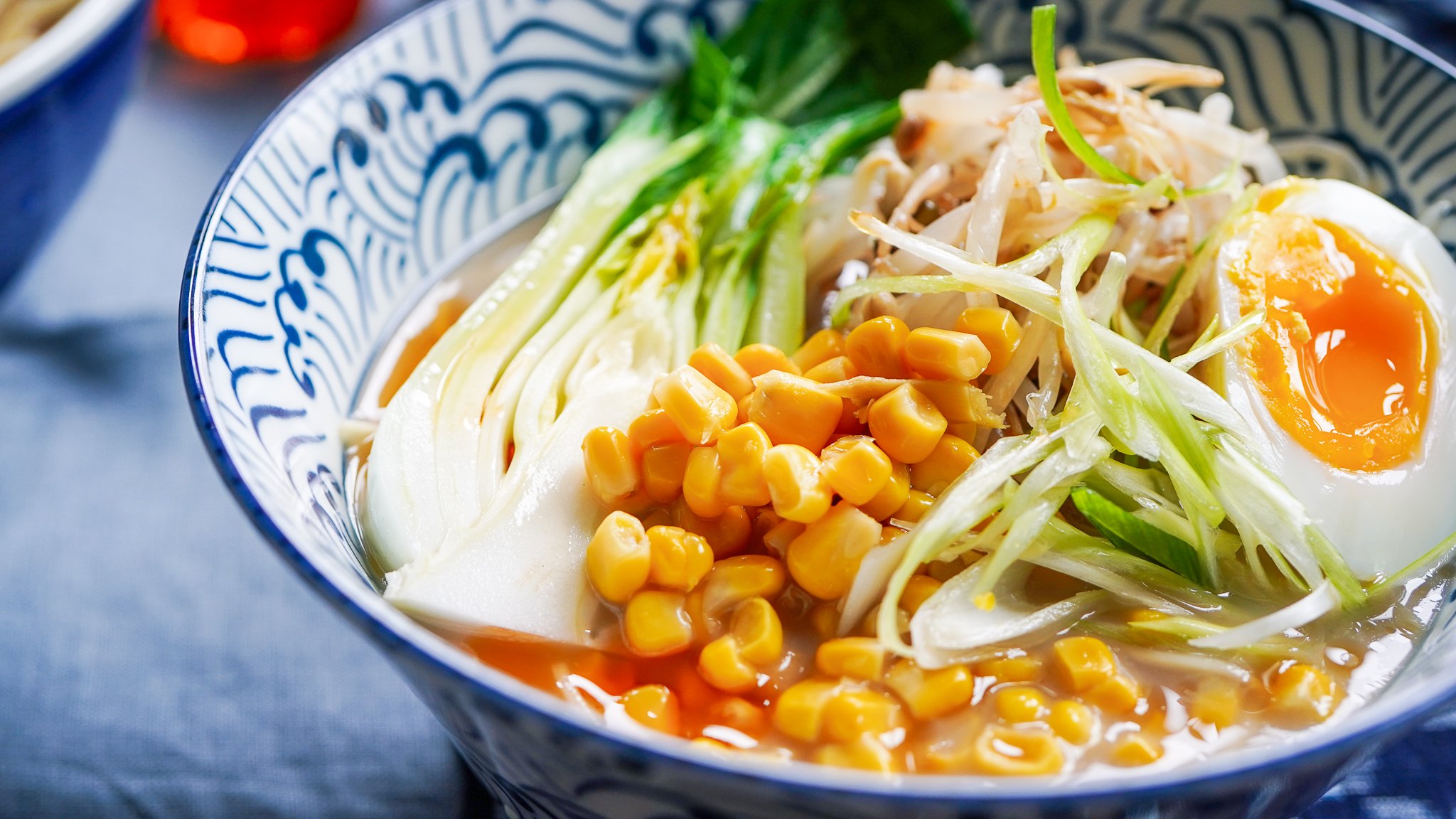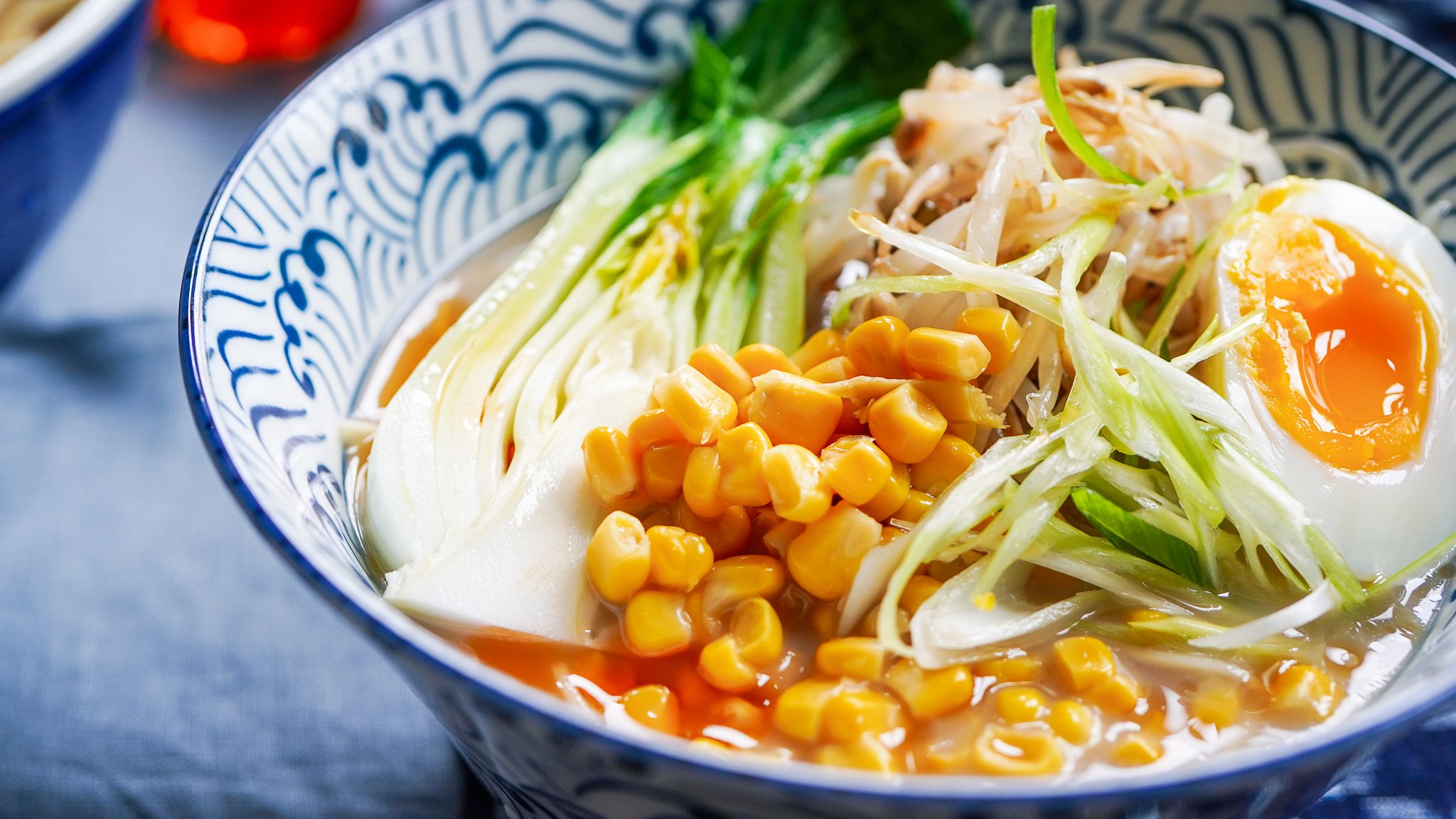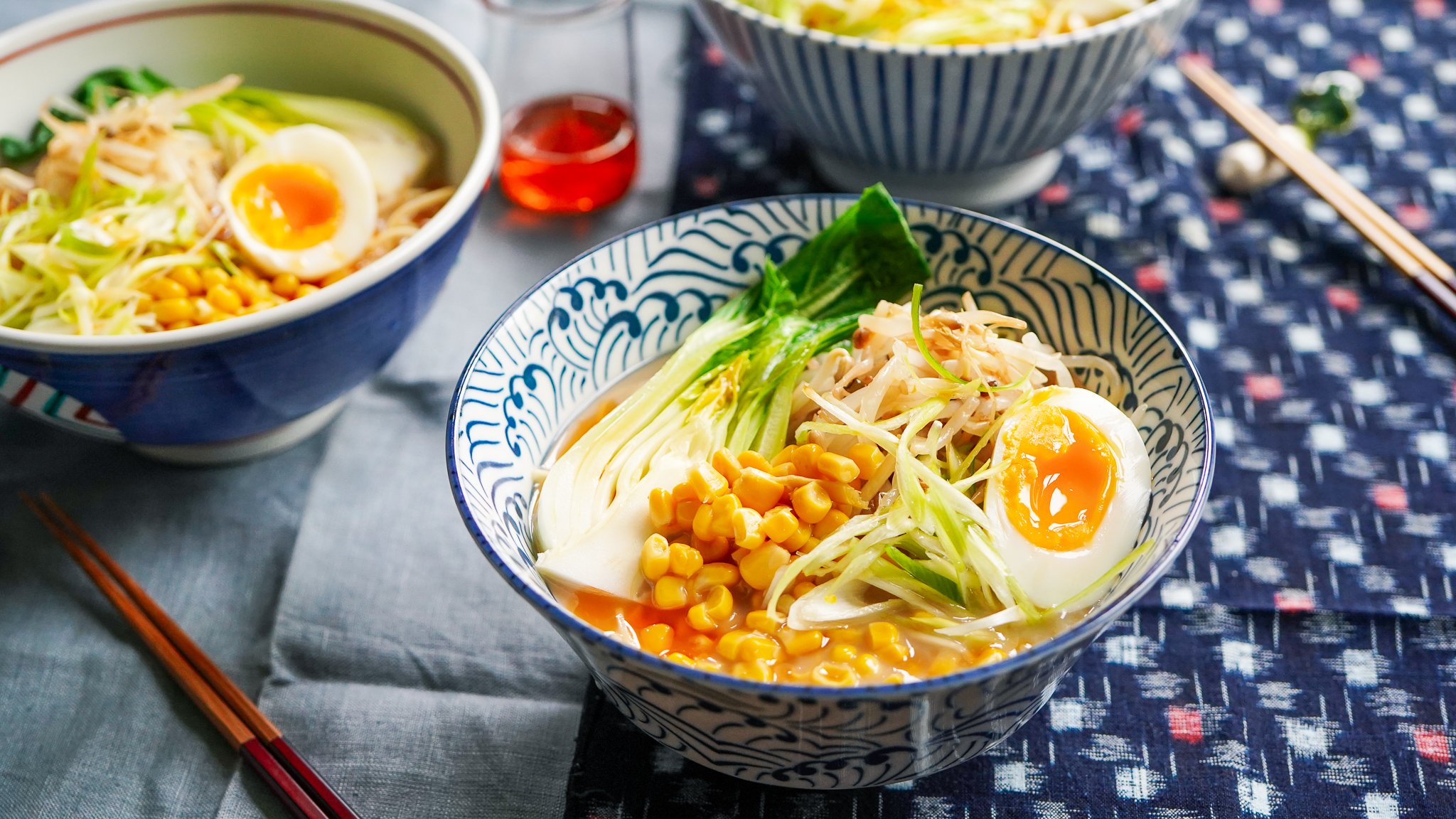Creamy Vegetarian Miso Ramen with Soya & Dashi Broth
I love making vegetarian ramen at home, it’s a perfect healthy weeknight recipe because it doesn’t take hours (or even days) to cook like traditional ramen can but is still rich in flavour. It's quick, simple, and delicious.
Making ramen is a fun and rewarding experience, I love teaching my vegan gyoza and ramen class and online vegan ramen class and really delving into how to make these classic Japanese dishes plant-based without sacrificing umami flavour. It’s also easy to make this recipe vegan by skipping the egg topping!
I originally wrote my vegetarian ramen recipes for Waitrose Magazine which you can read here. Below, you will find my original recipe using ingredients you can easily find at your local supermarket or Asian store.
Key ingredients for Vegetarian Miso Ramen
Here are some of the key ingredients that will make your homemade ramen special.
Soy milk and dashi
Soy milk is very popular in Japanese cooking, many people think soya milk is sweet but we actually use it in savoury dishes a lot! It’s particularly useful for making broth creamy and milky, particularly for vegetarian dishes, I use it a lot in the broth when making asuka nabe hot pot. It’s delicious and also very handy for people that follow a plant-based diet.
For this dish, you will be adding soy milk to your own vegetable broth; you can use a simple vegetable stock or you can add some kombu (kelp) and shiitake mushrooms to boost the flavour and make your own vegan dashi.
You can also use dashi powder for a quick umami broth, but make sure to check that it is vegetarian as it can contain fish flakes.
Miso
Miso provides the umami flavour and depth to this ramen. It’s best to use a good quality miso for this dish, either dark or light, which you can pick up in the Japan Centre or online from Clearspring (use discount code yukiskitchen15).
You can even try making your own homemade miso — it’s much easier than people think and is rich in nutrients and lower in sodium, though you will need to make it in advance as it will need time to ferment. You can join my homemade miso class if you would like to learn how to make several types of miso.
Toppings
The exciting thing about making homemade ramen is getting to choose your favourite toppings!
You can add any vegetables you like but I typically choose baby pak choi, greens, beansprouts, and sweetcorn. Sweetcorn may sound unusual but sweetcorn and miso ramen is a classic, the sweetness works with the umami flavour so well!
I also love to add crispy fried onions as a topping for this recipe which you can buy from Waitrose and other supermarkets. For a kick, I also recommend adding La-Yu Japanese chili oil La-Yu or shichimi togarashi (Japanese seven spice), you can buy them in any Asian supermarket but you can easily make your own Japanese spicy condiments, learn how in this chili oil and seven spice guide.
If you aren’t vegan, then adding a boiled egg is a classic ramen topping and adds some extra protein to the dish. I love to make them soft-boiled which is the typical way to serve them in Japan, and you can even let the boiled eggs marinate in soy sauce and mirin overnight for that savoury umami flavour.
The different ramen dishes you can find in Japan
We don’t traditionally have vegetarian and vegan ramen in Japan, and a vegan culture is not widespread, and asking the chef for changes to classic recipes has been considered disrespectful to the chef which means things have been very slow to change for people following a plant-based diet.
However, there are now many restaurants adapting ramen for vegans, and particularly in Tokyo, you will be able to easily find plant-based alternatives, especially from chains like Ippudo and Menya Musashi. Many changes were also held ahead of the 2021 Olympics ready for the huge influx of visitors to Japan.
I went on a ramen trip around Japan in 2019 and tried many amazing ramen dishes from different prefectures and cities. At that time, it was still 90% meat but I was starting to see more vegetarian and vegan restaurants around.
Though ramen typically follows a noodle in broth format, there are countless types of ramen in Japan and every region has its own unique recipe! Four of the famous ramen types that have become popular international include:
Shio ramen: a salt-based broth which is one of the original and lighter ramen varieties, it’s popular in Hakodate, a southern city in Hokkaido.
Tonkotsu ramen: in a milky pork broth which is packed with meaty flavour
Miso ramen: which originated in northern Hokkaido, it has a deep umami flavour
Shoyu ramen: is a soy-sauce based broth and very popular in the Kanto region of Japan, including Tokyo
There are also different kinds of noodles served depending on the region from different thicknesses and textures and toppings will vary widely from region to region including the classic pork belly cha shu and salty chicken.
Ramen is truly an experience in Japan.
If that got you hungry, here’s how you can make your own delicious vegetarian ramen at home.
I love to serve this dish with a sprinkle of Japanese seven spice, known as ‘shichimi togarashi’ and some grated ginger, which adds a zing and has its own excellent health benefits.
You should be able to find most ingredients at your local grocery store, you can find kelp on Amazon or your local Asian store.
For grating the daikon, I love to use this kyocera ceramic grater but you can also just use a cheese grater.
Here’s how to make this simple and healthy recipe at home.

Creamy Vegetarian Miso Ramen with Soya & Dashi Broth
Ingredients
- 160g dried ramen noodles or egg noodles
- 500ml of vegetable stock
- 5cm x 5cm of dried kombu (optional)
- 250ml unsweetened soy milk
- 1 tbsp of sake (optional)
- 2 tsp of mirin
- 1 tsp of Japanese soy sauce
- 1 tbsp or white or brown miso, or homemade miso
- 90g pack of baby pak choi
- 100g of beansprouts
- 3 spring onions, finely chopped
- 2 tbsp of frozen sweetcorn, defrosted
- 1 boiled egg, shelled and halved
- 1 tbsp of fried onions ( you can normally find these in the supermarket)
- Japanese chill oil “La-yu” or Shichimi Togarashi (Japanese Seven Spice)
Method
- First, make the soup. Drop the dried kombu (kelp) into the vegetable stock and infuse it for a half-hour or longer.
- Heat the stock with the kombu in a saucepan. Once it starts boiling, take out the kombu from the stock add the soy milk, sake (if using), mirin, and soy sauce.
- Remove from the heat and gradually stir in the miso. You can add more than 1 tbsp if you like – just taste and adjust as you go. The depth of flavour depends on the type and colour of miso (white or red) used.
- Steam or boil the baby pak choi for 2-3 minutes and blanch the beansprouts in boiling water for 1-2 minutes. Prepare any other toppings you are using.
- Cook the noodles and divide them between two bowls. Pour the soup over the noodles. Add the pak choi and beansprouts.
- Finally, top with salad onions, sweetcorn, egg, crispy onions and a drizzle of the chilli oil or a sprinkle of shichimi togarashi (if using).














